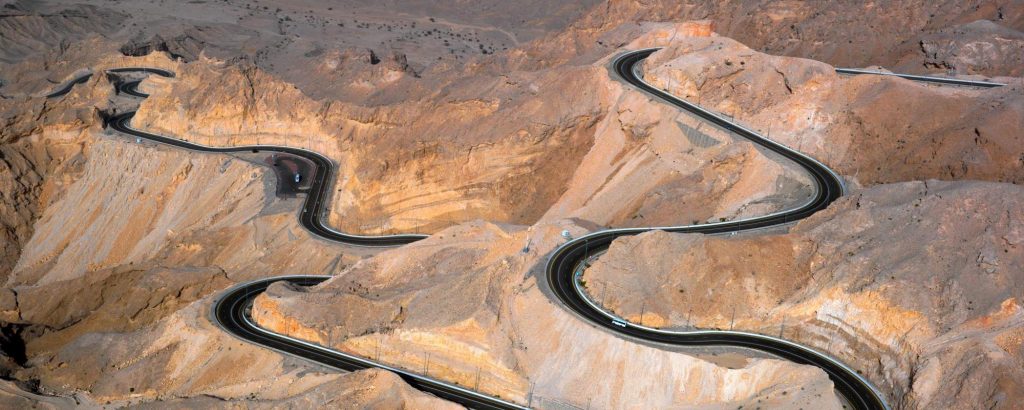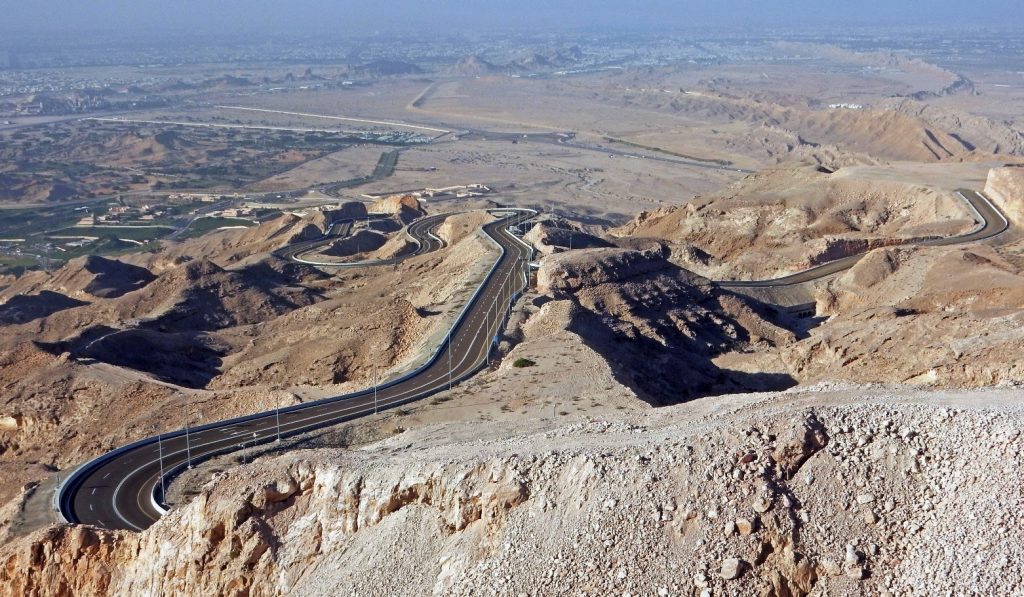Far away from the hustle and bustle of the busy city life, you come here at the top of the tallest mountain range to find real peace, silence, and a panoramic view of the garden city, i.e., Al Ain. This is Jabel Hafit, which at 3000 feet is the tallest mountain. A part of the Hajar Mountains range, Jabel Hafit separates the Omani city of Al Buiraimi and the UAE at Al Ain. It lies in the East of Abu Dhabi and the Tawam district, part of Al Ain.
Jebel Hafit means “Empty Mountain,” and it has great historical importance. Beehive-shaped burial grounds have been excavated from the Jebel Hafit mountains and showcased in the Al Ain Museum. These grounds belong to the Bronze Age (3500 BC to 3000 BC), the Hafit period. Many potteries, etc., have also been excavated from here.
Jebel Hafit Mountain is one of the biggest tourist attractions due to many other things. It is home to UAE’s only hot springs, where hot geyser water sprouts from stone. Then, there is beautiful Green at the foothills of Jebel Hafit called the Green Mubazzarah.
Jebel Hafit is also home to exotic animals hiding in deep, dark caves. Red Fox, Feral Cats, and Rock Hyrax are some of them. These are timid creatures, and you will be fortunate to spot one during a trip to Jebel Hafit. Snakes and Arabian leopards are also found in Jebel Hafit’s mountains. There is a complete list of things to do in Dubai if you wish to explore Dubai in all seasons.
It is a UNESCO site; the mountain is part of Jebel Hafit National Park.
Arriving and Staying at Jebel Hafeet, Al Ain
Jebel Hafit mountain drive from Dubai is almost 130 kilometers from Dubai and is the same distance from Abu Dhabi. It takes around 2 hours to drive from these two big brothers of the UAE. The road trip is super due to the fantastic roads the government has built. There is a lot of ‘Greening’ of the road through roadside planting of shrubs, palm trees, etc. The visit to Jabel Hafeet is not part of the regular Al Ain City Tour.
Note: It is always advisable to check your tires and Gasoline/ water level before climbing Jebel Hafit Mountain. This is because the climb is very steep, and you may not get the second option in between for gasoline. You get stuck until help arrives. It is better either to see the sunrise or the sunset. If you want to see the sunrise, start very early and reach by 4 a.m. in summer and 5.30 a.m. in winter.
The road to the top is 11.4 kilometers long and is a three-lane highway. It is rated as 1 of the top 10 best mountain roads globally. The road has two lanes for going up and 1 for coming down. You MUST drive carefully and wide awake as a constant roar of fast motorbikes crisscrossing you, fast cars, and their speed may even startle you. You should be wide awake because the road does not have a divider, and there can be a chance of an accident if you don’t pay attention.
At the peak, there is a big flat patch where you can park your car and enjoy the beautiful view of Al Ain. At night, the view is spectacular due to the glow of lights. The place is often very windy at that height. Although a steel net fully barricades the land, some open areas exist. It would help if you were careful about these areas. There is a small café here. Order your Karak chai and Indian-style coffee to enjoy the silence and serenity. The peak can become noisy as many travelers play music and do extempore dancing here.
Jebel Hafit’s snaking road meanders through many curves to reach the top. The first thing that will hit you is the view of Al Ain City and beyond. On one side, you can see Oman; on the other, you can see the UAE. Jebel Hafit is part of an ancient mountain range; hence, it is barren and flat. Millions of years of standing against the salty and disruptive wind have stripped it of its plants. Nothing can survive here, which is a testament to the life cycle of everything in this world.
Hotel Mercure in Jebel Hafeet

There is an excellent hotel on Jebel Hafit for you to stay in or to go for refreshments. This is called the Hotel Mercure. Open the corkscrews to a lovely evening atop the limestone behemoth and enjoy this 4-star hotel resort’s incredible comforts. Al Ain is the perfect way to appreciate how this site has been developed and preserved from the hotel, the night view of the perfectly lit mountain road, and the far-off Garden City.
The Green Mubazzarah and Hot Springs of Jebel Hafit
Al-Ain is the birthplace of Sheikh Zayed Al Nahayan, father of the nation and late ruler of Abu Dhabi, of which it is a part. The rules, until today, take great care of this city. Al-Ain City is one massive garden with lush green trees, blooming flowers, and landscaped squares. If you are driving through Al Ain, it will be a soothing nerve impact on you.
The same passion for greenery is evident even at the foothills of Jebel Hafit. There were only natural hot springs from which hot water sprouts would splash out. There was desert all around. Then, the Al Ain municipality decided to beautify it and convert it into a tourist paradise. The area is now called the Green Mubazzarah, with green fields, sit-out areas, and showers after you have your prancing around the hot water geysers. There are a lot of hotels also.
The Green Mubazzarah also has a children’s play area with slides and other activities.
Green Mubazzarah is the best place in Jebel Hafit to have a picnic. It is refreshing and soul-satisfying.
Your trip from Al Ain to Jebel Hafit and down to the Green Mubazzarah will be a full-day affair.
One essential thing to note is that the hot water stream floor is very slippery. The alluring natural water feels very energizing when you step into the stream. It has therapeutic qualities. However, as many minor accidents have been reported, you must take the utmost care while standing or walking through the stream. Put your feet firmly, and where possible, hold on to something. Instruct your kids to do the same. Also, the water may scald young ones as their skin is insensitive.
What is the Best Time to go to Jabel Hafit?

The best time of the year is October to March. These are the cooler months, and if you choose December, January, or February, you must be ready to be in a crowd as it becomes crowded with teeming cyclists, motorbikes, mountain walkers, and tourists worldwide. It would help if you planned to avoid disappointments. Traffic jams could also occur in peak season, especially during the rise.
April to July, off-peak months, have less traffic but can become hot. It is advisable to carry plenty of sun lotion, hats that protect you from the direct hit of sun rays, and plenty of water to keep up your hydration level.
Dining, staying, and Activities
There are plenty of dining options for every nationality. Depending on where you go to eat, dining may cost between AED 30 and AED 300 per person. Hotel Mercure may be a good option. Lunch and dinner are mostly continental, Arabic, and Italian. The Le Belvedere serves Italian food with an Emirate twist. You can cool off with Orient Café’s various coolants, especially in summer.
Below, in Green Mubazzarah, you will get many, including Coriander for Indian food, Flavours, Traders’ Vic, Tanjore, Pizzaro, TGI Fridays, and Gazebo, etc. This is a minimal list, and you may go and explore more. Al-Ain is not a very big city, but dining options are enormous. There are malls like Bawadi Mall, Jimi Mall, and Al Ain Mall close by, and you can do a bit of shopping and enjoy a variety of sumptuous food in their food court.
Top Five Activities to do
- Go shopping after you return from Jebel Ali for gifts for family and friends back home.
- Visit Al Jimi Fort as well as the Sheikh Zayed Palace Museum.
- Visit the iconic Al Ain Zoo, feed Giraffes, and enjoy a buggy ride to see the most different animals in the Middle East.
- Visit the Al Ain Museum
- Take your kids to Hili Fun City so that they can enjoy various rides
We could make this a more exhaustive Top 10, but we know you need to return to it. Hence, we chose the best of the five actions. There is a balance between what kids would enjoy and something for you.
We recommend that you enjoy the garden city, its fresh air, its almost traffic-free roads, and the efforts that the municipality is making to live up to the vision of Sheikh Zayed Al Nahyan, the late ruler of Abu Dhabi and a great environmentalist.
